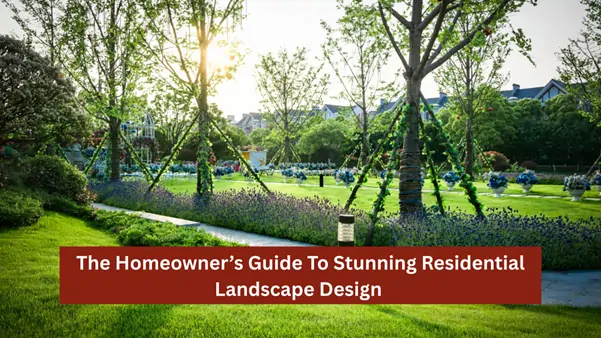Table of Contents
ToggleDo you dream of a yard that truly makes people sit outside and take notice?
To design an incredible residential landscape, there is more involved than dumping some mulch. You need a sharp eye and an organized plan to turn your outdoor space into a masterpiece. A solid landscape significantly elevates the value of your residence, which is an added monetary benefit.
Retrofitting your yard is an excellent undertaking. Homeowners need to approach it methodically, just like they would any significant home remodel. You want the result to be stunning, extremely functional, and valuable in the long term. This guide takes you through the key steps of transforming a simple concept into a gorgeous reality step by step.
1. Have a Solid Plan
All good landscapes start with a good plan. You want to know what you want to do with your exterior this year. Begin by taking stock of your property and noting all of the permanent features already located on it. That includes mature trees, borders, and all locations of utility access, such as meters or septic fields.
You must consider the significant environmental conditions around your property. Watch the sun’s path throughout the day to determine where you need the shade structures or sun-loving plants. Note any drainage issues that currently persist, including water remaining after a storm, and incorporate grading solutions into your design. A good residential landscape design prevents costly errors. It ensures your design adapts well to your land, taking full advantage of natural advantages.
2. Determine Desired Features

What are the specific features that would make your yard really special for you and your family’s lifestyle? Some families need a quiet, serene, and hidden sanctuary to escape from daily stresses. Others would prefer an active entertainment area perfect for hosting large gatherings and summer barbecues.
Start by making a list of the various functional elements you desire.
You may require a fire pit seating area for cold winter nights, a raised-bed vegetable garden to pick fresh ingredients, or a natural water feature close to the back patio. Or could you need a play area specifically for children, utilizing some surfacing materials? Rank your list so that your top priorities are items that fit within your budget and lot size. By ordering your must-haves, installation becomes much simpler.
3. Master Sand & Gravel Techniques
Sand and gravel are wonderful, tactile design mediums that add beauty and functionality. You can employ them to deliver rich texture and define authoritative style in your garden beds and walkways. An example is a walkway constructed of crushed decomposed granite for a natural, permeable, rustic look that is fitting for cottage style.

These materials also play a crucial part in water retention and drainage around the yard. They allow rainwater to travel through to the ground, limiting surface runoff and erosion on slopes. That is one homeowner’s greatest triumph.
4. Integrate Comfort & Function
Your yard needs to be cozy and functional to become a real living space outside. How will you go about making your yard look like a real, live-in extension of your inside home? Consider how you will use, or wish to use, the area on a regular day-to-day basis. Will you be utilizing it for cooking, or mostly resting?
Begin by designing separate outdoor “rooms” based on their function and order from your residence. Set a central patio off the kitchen as a dining space and a totally separate, private bench space under a pergola for reading and working.
Invest in heavy-duty, attractive outdoor furniture that can withstand your specific environmental conditions. Well-positioned lighting is essential both from a safety perspective and in generating a convivial, functional ambiance at night.
5. Use Eco-Friendly Alternatives
Smart design decisions help the world in several ways. Apart from “look & feel”, they cut a large chunk out of your long-term upkeep time and expensive utility bills. Try using xeriscaping, which reduces the demand for additional watering after it is established. Residents should always use native plants that multiply in the local environment.
Native plants require less watering, no or minimal fertilizer, and naturally fight off frequent neighborhood pests and diseases. That is much better than susceptible non-native plant life. You can also install a basic system to harvest rainwater in decorative barrels for irrigation. Installing permeable pavement materials for driveways manages stormwater runoff and recharges groundwater. That helps maintain sustainability for the garden and property.
6. Seek Expertise Guide

In certain cases, a full do-it-yourself solution to a full landscape design is too much and too complex for one to accomplish. A professional landscape designer offers experience that makes the whole project extremely efficient. They can take your initial general ideas and turn them into a usable, buildable, and stunning plan that is also code-compliant.
An experienced designer is familiar with grading needs, ground content, and how to make plant displays endure. They will spare you a ton of money by avoiding costly, poor-quality errors. Isn’t something properly designed and neatly completed worth the dollars invested? Seek professional advice when needed for items you cannot source.
Summing Up
Designing a beautiful home landscape is an astounding endeavor that enhances your home life immensely. It is an art of careful planning, thoughtful material selection, and an unwavering drive for both enduring beauty and maximum utility. Your landscape is a long-term, worthwhile investment in your home’s beauty and your lifestyle. It is prudent to lay down the plan and master the products you will use and where each planned item stands to ensure a picturesque garden.
Read more: What is an Overload Relay and How Does it Protect Motors?
7 Ways Online English Tutoring Helps Students Master Writing Skills

